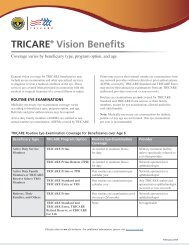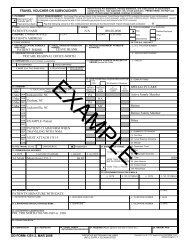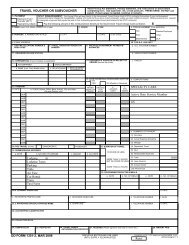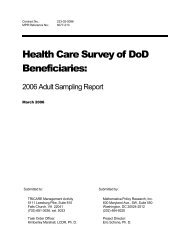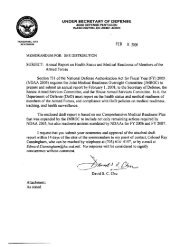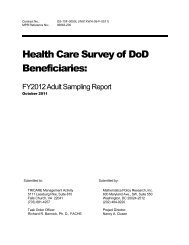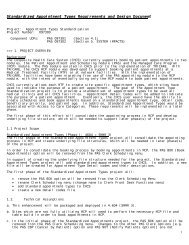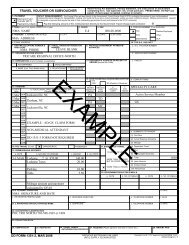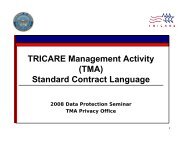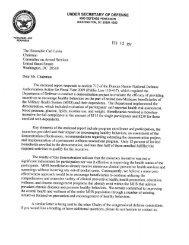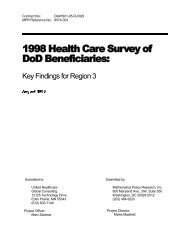Medical Management Guide, 2009, Version 3.0 - Tricare
Medical Management Guide, 2009, Version 3.0 - Tricare
Medical Management Guide, 2009, Version 3.0 - Tricare
- No tags were found...
You also want an ePaper? Increase the reach of your titles
YUMPU automatically turns print PDFs into web optimized ePapers that Google loves.
<strong>Medical</strong> <strong>Management</strong> <strong>Guide</strong><strong>Version</strong> <strong>3.0</strong>Case <strong>Management</strong>Page 63The case manager evaluates referrals using criteriaidentified in the CM plan to ascertain whether thebeneficiary has either CM or care coordinationneeds. One way for providers to refer patients isthrough completion of Standard Form (SF) 513,which may be sent electronically through the ArmedForces Health Longitudinal Technology Application(AHLTA) or other approved electronic systems (seeSection V, <strong>Medical</strong> <strong>Management</strong> Tools).CD-ROM Resources CM-3 and CM-4 provideblank and completed versions of SF 513.An approach known as “predictive modeling”(Meek, 2003) may be used to identify a narrowlydefined group of patients for CM (see Section I,<strong>Medical</strong> <strong>Management</strong> Essentials, andCD-ROM Resources MME-2 and MME-3).The John Hopkins Adjusted Clinical Groups (ACG)Case-Mix System measures morbidity by, amongother things, forecasting healthcare utilization. TheACG system evaluates patient populations based ondisease patterns, age, and gender.More specifically, the Johns Hopkins ACGmethodology is used to:• Predict high-risk users for inclusion in CM.• Determine government- or employer-budgetedpayment to health plans.• Allocate resources fairly within programs.• Set capitation payments for provider groups.• Evaluate access to care.• Assess the efficiency of provider practices.• Improve quality.• Monitor outcomes.For more information, go to: http://www.acg.jhsph.edu/html/AboutACGs.htm.Triggers for Potential ReferralThe MHS supports a population-based approachto CM, which coordinates care and services forgroups with similar characteristics. Coordinatingcare for groups of people before they are at riskis a key preventive measure in Population Healthimprovement. (See Executive Summary,CD-ROM Resource ES-1, 2001 DoD PopulationHealth Improvement Plan and <strong>Guide</strong>, or go to:http://www.tricare.mil/ocmo/download/mhs_phi_guide.pdf. Publication of the next iteration ofthe <strong>Guide</strong> is expected in summer 2010. See alsoSection I, <strong>Medical</strong> <strong>Management</strong> Essentials,The Link between <strong>Medical</strong> <strong>Management</strong> andPopulation Health.)The following are appropriate triggers for referral toCM (see also Section II, Utilization <strong>Management</strong>,Referral <strong>Management</strong>). Sometimes referral isbased on a diagnosis, condition, or family situation,but other factors include:• Spinal cord injury.• Head injury – traumatic and non-traumatic.• Serious trauma.• Psychological disorder (including suicide risk).• Multiple chronic illnesses.• Cancer diagnosis.• Neonatal Intensive Care Unit (NICU) admission.• Transplant* or burn.• Dual diagnosis.• Blindness.• Amputation.• Poly-substance abuse (can be a result ofpolypharmacy — when the patient hasbeen prescribed seven or eight concurrentmedications).



